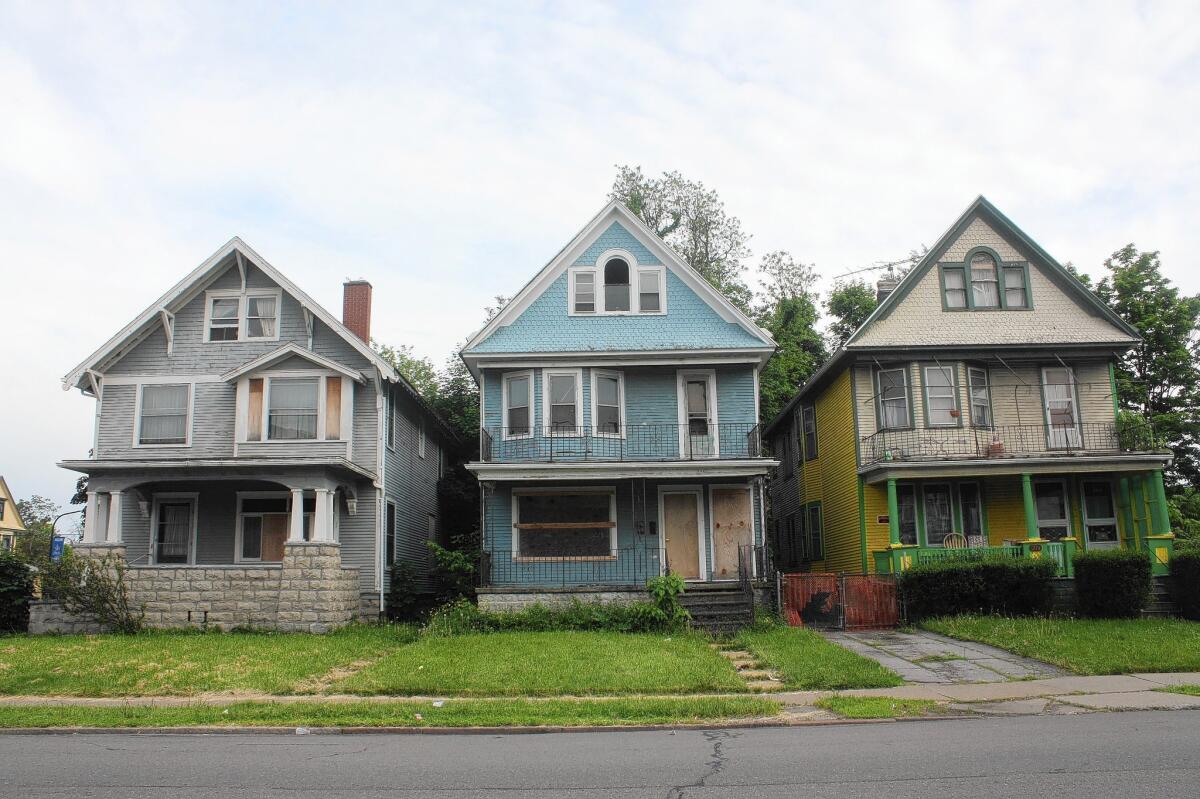As an alternative to demolition, Buffalo offers homes for a dollar

Reporting from Buffalo, N.Y. â The breeze carries the tinny jingle of the approaching ice cream truck, so Mike Puma leaves the railing heâs painting on his two-family, electric-blue home to buy a milkshake.
He pays more for the shake than he did his entire home.
Of course, when he bought this home for $1 this year, it had a demolition notice on the door, walls the consistency of a Three Musketeers bar and mold coating the ceilings. But Puma, 24, feels that he got a bargain. Plus, he takes pleasure in knowing that this century-old house will not be torn down.
âWeâre reintroducing new life into these properties,â he said. âNot only are you taking a stand against demolition, but youâre taking a stand on what happens in this city.â
Across the Rust Belt, cities are beginning to tear down tens of thousands of vacant homes. But Puma and a small group of other activists in Buffalo are battling the demolition process, trying to find residents to buy the fixer-uppers.
Puma alone has saved two houses on his block by persuading friends to buy them though Buffaloâs Urban Homestead program, which allows residents to buy homes for a dollar if they show they have the resources to make necessary repairs and promise to live in them for at least three years.
Gary, Ind., launched its own version of the Dollar Home program last year with an initial six houses sold for $1 each. Other cities, including Philadelphia and Detroit, allow homeowners to acquire vacant lots next door for a small sum.
Puma said Americans were too quick to destroy old homes, and he is fighting âthe never-ending rumble of demolition equipment.â
Cities demolish salvageable buildings because thereâs political incentive to clear up blight, said David Torke, a neighborhood activist and blogger who works with Puma to save old homes.
The money spent on demolition â $15,000 a home â could be spent to repair the houses and make them habitable, Torke said.
âWe think of ourselves as emergency room doctors dealing with a catastrophe, and we have to rely on a system of triage,â Torke said. âProblem is that weâre not dealing systematically with the catastrophe thatâs before us, and weâre sending patients who have bumps and bruises to the landfill.â
While selling a home for a dollar sounds like a catchy solution to a pervasive problem in the Rust Belt, itâs not as simple as it appears.
Most of the homes require tens of thousands of dollars of work, so fixing one up can cost as much as buying a different house thatâs move-in ready.
There are still not enough jobs in Buffalo to attract people to save the homes and then live in them for three years. In popular areas of the city that are turning around, thereâs little incentive to sell the homes for a dollar.
âYouâre seeing a strong resurgence of the idea â letâs try to work with what we have, not just clear everything and build anew,â said Justin Hollander, a professor of urban planning at Tufts University in Boston who studies shrinking cities. âBut the fact is these Dollar Homes are generally in neighborhoods with high crime. Itâs not a panacea.â
Creighton Randall bought a Dollar Home from the city of Buffalo in 2008 and has been working on it on and off ever since.
It was a much bigger investment than he anticipated in terms of time and money. Two winters ago, he and his wife huddled in a 400-foot insulated area with an electric heater because they didnât have the cash to install a heating system.
âIf I had to do it again, I wouldnât,â said Randall, who has since left Buffalo for a job opportunity. âI should have just bought one of the houses on sale for $13,000 and saved myself a lot of time.â
There are about 4,600 vacant homes in Buffalo and 16,000 vacant lots, said Brendan Mehaffy, executive director of Buffaloâs Office of Strategic Planning.
On average, about eight to 10 homes a year are bought through the Dollar Home program. Hundreds more are on the demolition list.
The idea of the Dollar Home program is all well and good, Mehaffy said, but when no one steps forward to buy the homes, neighbors complain about blight, rodents or crime, and the city is pressured to demolish.
âWe donât have a desire to demolish properties,â he said. âThere is a need to demolish properties.â
Still, itâs hard to overlook the atmosphere on the blocks where Puma and Torke have been able to save homes. Rather than the weed-filled empty lots that plague much of Buffalo, there are brightly painted Queen Anne homes with spacious vegetable gardens and jungle gyms on side lots.
On a tour of Buffalo, Torke drives by the narrow street of Coe Place, where he first saved a house from demolition in 2006. Thereâs now a freshly painted orange Queen Anne house on the street; a few doors down, a brown Victorian boasts a new deck and a flowering garden.
A few blocks away, thereâs a brick cottage from 1886 that was facing the wrecking ball until Torke found a man who lived in the suburbs to buy it for a dollar.
âWeâre relying on the grit and grace of individuals who have a lot of tolerance for risk to establish a really interesting community,â Torke said. âBesides, I donât take no for an answer.â
Torke, 52, said heâs now handing over the reins of finding buyers for Dollar Homes to Puma. Itâs a more appropriate task for someone young who has the energy to save his own home, and others too.
Puma seems to have boundless optimism for even the most intimidating of projects. The walls, ceilings and floors of his house are stripped bare, thereâs no plumbing or electricity, and wires still hang from the ceiling.
He works on the house all day on the weekends and then a few nights a week after work.
Across the street, his neighbor Kevin Harris, who has lived on the block for 21 years, watched admiringly as Puma painted the railing of his second-story balcony.
âAt one point, I thought they were going to tear that house down,â Harris said. âBut theyâre really working their butts off over there, and itâs a beautiful thing. Iâd rather see that home than an empty lot any day.â
More to Read
Sign up for Essential California
The most important California stories and recommendations in your inbox every morning.
You may occasionally receive promotional content from the Los Angeles Times.











